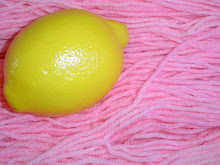Rosebud Singles
 Over the weekend I finished spinning the third bobbin of Rosebud singles and once they get a few days for the twist to even out, I'll ply them. Most people recommend plying when your singles are fresh and the twist is at it's most active*, but since I finished the first bobbin about a week ago, there's no way the recently finished bobbins will have the same level of twist. After attempting to ply singles with different levels of active twist when I first began spinning, I figured out that it just doesn't work for me very well. I can still get a balanced yarn, but the singles coming off the bobbins get really squirrelly and cause all sorts of problems if some are active and others are more dormant.
Over the weekend I finished spinning the third bobbin of Rosebud singles and once they get a few days for the twist to even out, I'll ply them. Most people recommend plying when your singles are fresh and the twist is at it's most active*, but since I finished the first bobbin about a week ago, there's no way the recently finished bobbins will have the same level of twist. After attempting to ply singles with different levels of active twist when I first began spinning, I figured out that it just doesn't work for me very well. I can still get a balanced yarn, but the singles coming off the bobbins get really squirrelly and cause all sorts of problems if some are active and others are more dormant.*When you spin a singles yarn, immediately after you spin it you have what's called "active twist." This is really a nice, technical way of saying that if you were to take your singles off the bobbin and try to wind a skein, you would have a crazy mess. Once the singles have a chance to sit on the bobbin for a bit (even 48 hours makes a huge difference in how singles behave), the twist begins to be "set" into the fiber and the singles will be less twisty and crazy. Once you add steam or water to the singles, it reactivates the twist and it goes back to having active twist. Usually when you steam or soak the yarn, it's not as a singles, but as a plied yarn and when the twist reactivates, it is controlled by the plying twist (opposite to the original spinning twist) and they even each other out.
Labels: spinning










7 Comments:
Thank you for the information I'm a new spinner and always love to learn more.
I agree. I leave my singles to rest on the bobbin for a bit before plying. Especially when the first bobbin has been resting for double that time. Lovely handspun!
Love, love, love! The singles look great, will wait anxiously to see the finished yarn.
Argh - somehow I didn't get my first comment to post. I'm curious how you spin singles that have inactive twist. I have some bobbing of singles that have sat around for several weeks and when I ply them like I normally do, they look horrible. Is there some trick that I'm missing?
I was taught to let the singles rest before plying but to keep a sample of them done with active twist for reference. If your singles sat too long for that, pull off a length and put it in some hot water and watch! It'll take on it's "real" twist.
It looks so pretty
For M1- If you ply the aged singles until they don't curl back on themselves, you will have underplied yarn. Use Catspaw's technique of sticking a bit of singles (plied like you would ply the finished yarn) in a bowl of warm water to reactivate the twist so you can see what your plied yarn should look like.
HTH, Melanie
Post a Comment
<< Home